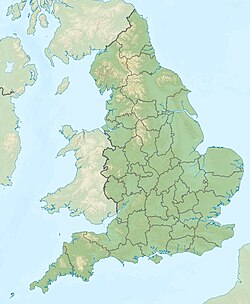| Bromsgrove Sandstone | |
|---|---|
| Stratigraphic range: Anisian ~247.2–242 Ma PreꞒ Ꞓ O S D C P T J K Pg N | |
| Type | Formation |
| Unit of | Sherwood Sandstone Group |
| Lithology | |
| Primary | Sandstone |
| Other | Shale, conglomerate, marl |
| Location | |
| Coordinates | 52°42′N 2°18′W / 52.7°N 2.3°W / 52.7; -2.3 |
| Approximate paleocoordinates | 15°36′N 10°48′E / 15.6°N 10.8°E / 15.6; 10.8 |
| Region | |
| Country | |
  | |
The Bromsgrove Sandstone is a geologic formation of the Sherwood Sandstone Group in England. It preserves fossils and ichnofossils of Chirotherium barthii, and Chirotherium sickleri, dating back to the Middle Triassic (Anisian) period.
Fossil content
- Bromsgroveia walkeri
- Bromsgroviscorpio willsi
- Ceratodus laevissimus
- Cyclotosaurus leptognathus, C. pachygnathus
- Langeronyx brodiei
- Mesophonus perornatus, M. pulcherrimus
- Palaeosaurus cylindrodon
- Rhombopholis scutulata
- Spongiophonus pustulosus
- Stenoscorpio gracilis, S. pseudogracilis
- Willsiscorpio bromsgroviensis
- Acrodus sp.
- Dipteronotus sp.
- ?Gyrolepis sp.
- Mastodonsaurus sp.
- Archosauria indet.
- Dinosauriformes indet.
- Nothosauria indet.
- Rhynchosauridae indet.
See also
References
- Bromsgrove Sandstone at Fossilworks.org
Further reading
- M. J. Benton and A. D. Walker. 1996. Rhombopholis, a prolacertiform reptile from the Middle Triassic of England. Palaeontology 39(3):763-782
- M. J. King, W. A. S. Sarjeant, D. B. Thompson and G. Tresise. 2005. A Revised Systematic Ichnotaxonomy and Review of the Vertebrate Footprint Ichnofamily Chirotheriidae from the British Triassic. Ichnos 12(4):241-299
- E. N. Kjellesvig-Waering. 1986. A restudy of the fossil Scorpionida of the world. Palaeontographica Americana 55:1-287
- R. I. Murchison and H. E. Strickland. 1837. On the upper formations of the New Red System in Gloucestershire, Worcestershire, and Warwickshire; showing that the Red or Saliferous, including a peculiar band of sandstone, represent the "Keuper" or "Marnes irisées;" with some account of the underlying sandstone of Ombersley, Bromsgrove, and Warwick, priving that it is the "Bunter Sandstein" or "Grès bigarré" of foreign geologists. Transactions of the Geological Society of London, series 2 5(26):331-348
- L. J. Wills. 1910. On the fossiliferous lower Keuper rocks of Worcestershire, with descriptions of some of the plants and animals discovered therein. Proceedings of the Geologists' Association 21:249-331